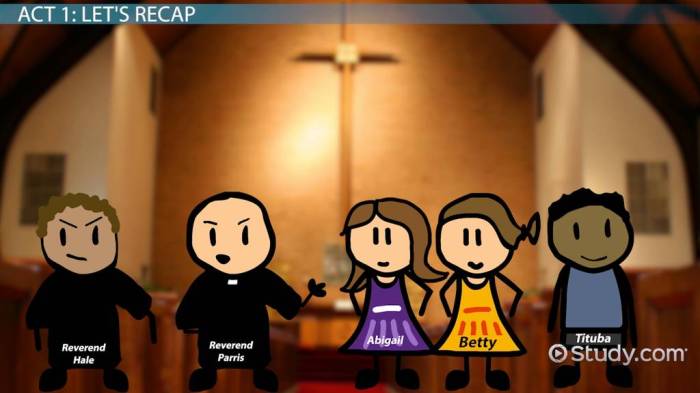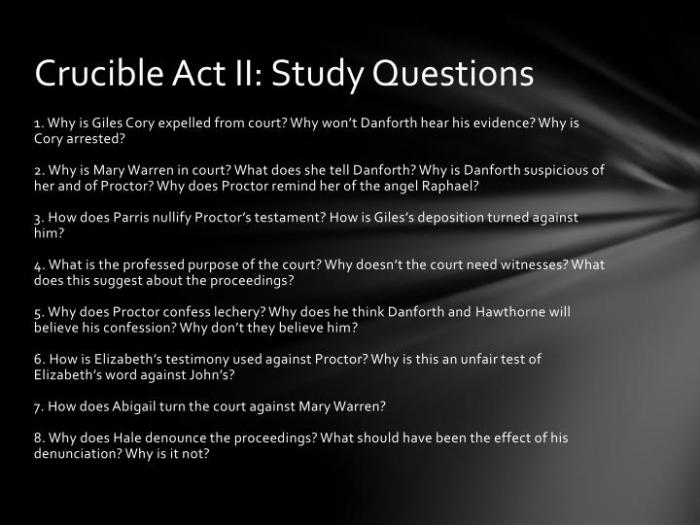Embark on an in-depth exploration of The Crucible Act Two study questions. This guide delves into the intricacies of the play, providing a thorough understanding of its characters, themes, symbolism, social commentary, and dramatic structure. Engage with thought-provoking insights and gain a comprehensive grasp of this literary masterpiece.
Through a meticulous examination of Act Two, this guide unveils the motivations and complexities of Abigail Williams, explores the pervasive themes of guilt and redemption, and analyzes the potent symbolism of the crucible. It sheds light on the strictures of Puritan society and the dangers of mass hysteria, while delving into the evolving relationship between John and Elizabeth Proctor.
Character Analysis: Abigail Williams

Abigail Williams, a central character in Arthur Miller’s “The Crucible,” is a complex and enigmatic figure whose actions have profound consequences for the community of Salem. Driven by a combination of jealousy, ambition, and fear, Abigail emerges as a catalyst for the escalating hysteria that grips the town.
Manipulative and Cunning Behavior
Abigail’s manipulative nature is evident from the outset. She exploits the guilt and fear of the young girls involved in the witchcraft accusations, using her charisma and persuasive abilities to convince them to participate in her schemes. Her cunning is also apparent in her ability to turn the tables on her accusers, manipulating the situation to her advantage.
Role as a Catalyst
Abigail’s accusations against Elizabeth Proctor ignite a chain reaction that ultimately leads to the mass hysteria and persecution in Salem. Her desire to eliminate Elizabeth as a rival for John Proctor’s affections drives her to make false accusations, which in turn create an atmosphere of suspicion and fear that permeates the entire community.
As the accusations escalate, Abigail’s influence over the young girls intensifies, and she becomes the driving force behind the escalating hysteria. Her ability to control and manipulate the girls’ testimonies allows her to shape the course of events, ultimately leading to the tragic consequences that befall the community.
Symbolism

Arthur Miller’s “The Crucible” is replete with potent symbolism, and the crucible itself stands as a central and multifaceted metaphor that enriches the play’s thematic exploration.
The crucible, a vessel used to test the purity of metals through intense heat, serves as a metaphor for the Salem witch trials. The trials, fueled by mass hysteria and baseless accusations, subjected the accused to intense scrutiny and relentless pressure, akin to the searing heat of the crucible.
The Crucible as a Metaphor for Trials and Tribulations, The crucible act two study questions
The crucible represents the trials and tribulations faced by the characters in the play. Just as metals are tested for their strength and resilience in a crucible, the characters are tested by the relentless accusations and suspicions that engulf Salem.
The trials force them to confront their own inner demons, hidden secrets, and moral dilemmas.
The crucible also symbolizes the transformative power of adversity. Through the trials, the characters are forced to re-evaluate their beliefs, values, and relationships. Some emerge stronger and more resolute, while others succumb to the pressure, revealing their true nature.
The Crucible as a Transformative Force
The crucible acts as a transformative force that alters the characters in profound ways. The trials expose their hidden flaws, weaknesses, and strengths. Some characters, like John Proctor, are tested and emerge with their integrity intact, while others, like Abigail Williams, are consumed by their own malevolence.
The crucible also transforms the community of Salem. The trials create an atmosphere of fear and distrust, tearing apart relationships and eroding the bonds that once held the community together. The crucible ultimately serves as a cautionary tale about the destructive power of mass hysteria and the importance of due process and individual conscience.
Social Commentary: Puritan Society: The Crucible Act Two Study Questions
Arthur Miller’s “The Crucible” offers a scathing critique of theocracy and mass hysteria through its depiction of Puritan society in Salem.
Strict Social and Religious Norms
Salem’s Puritan society adhered to a rigid moral code based on the teachings of Calvinism. This code emphasized predestination, original sin, and the importance of hard work and conformity. Social hierarchies were strictly defined, with the clergy at the top and women and the poor at the bottom.
Witch Hunt and Persecution
These norms fostered a climate of fear and suspicion that contributed to the witch hunt. The belief in the devil and witchcraft was deeply ingrained in Puritan society, and any deviation from social norms was seen as a sign of evil.
As tensions rose, accusations of witchcraft became a way for individuals to settle personal grudges or eliminate perceived threats.
Critique of Theocracy and Mass Hysteria
“The Crucible” exposes the dangers of theocracy, where religious authority becomes synonymous with political power. The play shows how fear and paranoia can spread unchecked, leading to the persecution of innocent individuals. Miller’s critique extends to the dangers of mass hysteria, where reason and common sense are abandoned in favor of fear and prejudice.
Dramatic Structure: Act Two

Act Two of The Cruciblemarks a significant turning point in the play, as the accusations of witchcraft intensify and the tensions within the community escalate. This act serves as a catalyst for the events that will unfold in the rest of the play, and Miller employs various dramatic devices to build suspense and foreshadow future events.
Key Events and Plot Points
| Scene | Key Events |
|---|---|
| Scene 1 | – Abigail and the other girls are caught dancing in the woods by Reverend Parris.
|
| Scene 2 | – John Proctor confronts Abigail about her accusations, but she remains defiant.
|
| Scene 3 | – John Proctor arrives in Salem and confronts Abigail in court.
|
Rising Tension and Conflict
Act Two is characterized by a palpable sense of rising tension and conflict. The accusations of witchcraft create a climate of fear and suspicion within the community, and the lines between truth and falsehood become blurred. As the accusations escalate, the conflict between John Proctor and Abigail Williams intensifies, and the stakes become increasingly high.
Dramatic Devices
Miller employs several dramatic devices to build suspense and foreshadow future events in Act Two. These include:
- Irony:The accusations of witchcraft are ironic because they are based on superstition and fear, rather than on any real evidence.
- Foreshadowing:The events of Act Two foreshadow the tragic events that will unfold in the rest of the play. For example, Abigail’s defiance of John Proctor foreshadows her willingness to destroy anyone who gets in her way.
- Suspense:Miller uses suspense to keep the audience on the edge of their seats. For example, the audience is left wondering whether John Proctor will be able to expose Abigail’s lies and save himself and Elizabeth.
Character Relationships: John Proctor and Elizabeth Proctor
John and Elizabeth Proctor’s relationship is a complex one, marked by both love and conflict. In Act Two, their relationship is tested by the accusations of witchcraft that have been leveled against them. John is accused of lechery with Abigail Williams, while Elizabeth is accused of practicing witchcraft.
These accusations put a strain on John and Elizabeth’s relationship. John is angry and frustrated, while Elizabeth is fearful and withdrawn. However, despite these challenges, their relationship remains strong. They both know that they are innocent of the charges against them, and they are determined to fight for their lives.
John Proctor’s Character
- John Proctor is a complex and tragic figure. He is a good man who is caught up in a web of lies and deceit.
- He is a strong and independent man who is not afraid to stand up for what he believes in.
- However, he is also a flawed man who makes mistakes.
- His relationship with Abigail Williams is a major source of conflict in the play.
Elizabeth Proctor’s Character
- Elizabeth Proctor is a strong and independent woman. She is a devoted wife and mother.
- She is also a woman of faith who believes in the power of God.
- However, she is also a woman who is afraid of the unknown.
- Her relationship with John Proctor is a source of strength and support for her.
FAQs
What is the significance of the crucible in the play?
The crucible symbolizes the trials and tribulations faced by the characters, as well as the transformative power of adversity.
How does guilt manifest itself in the characters of The Crucible?
Guilt manifests in various ways, such as Abigail’s remorse over her actions, John Proctor’s struggle with his past infidelity, and Elizabeth Proctor’s sense of shame.
What are the key events and plot points in Act Two?
Key events include the arrest of John Proctor, the confrontation between Abigail and Elizabeth, and the escalating tensions within the community.